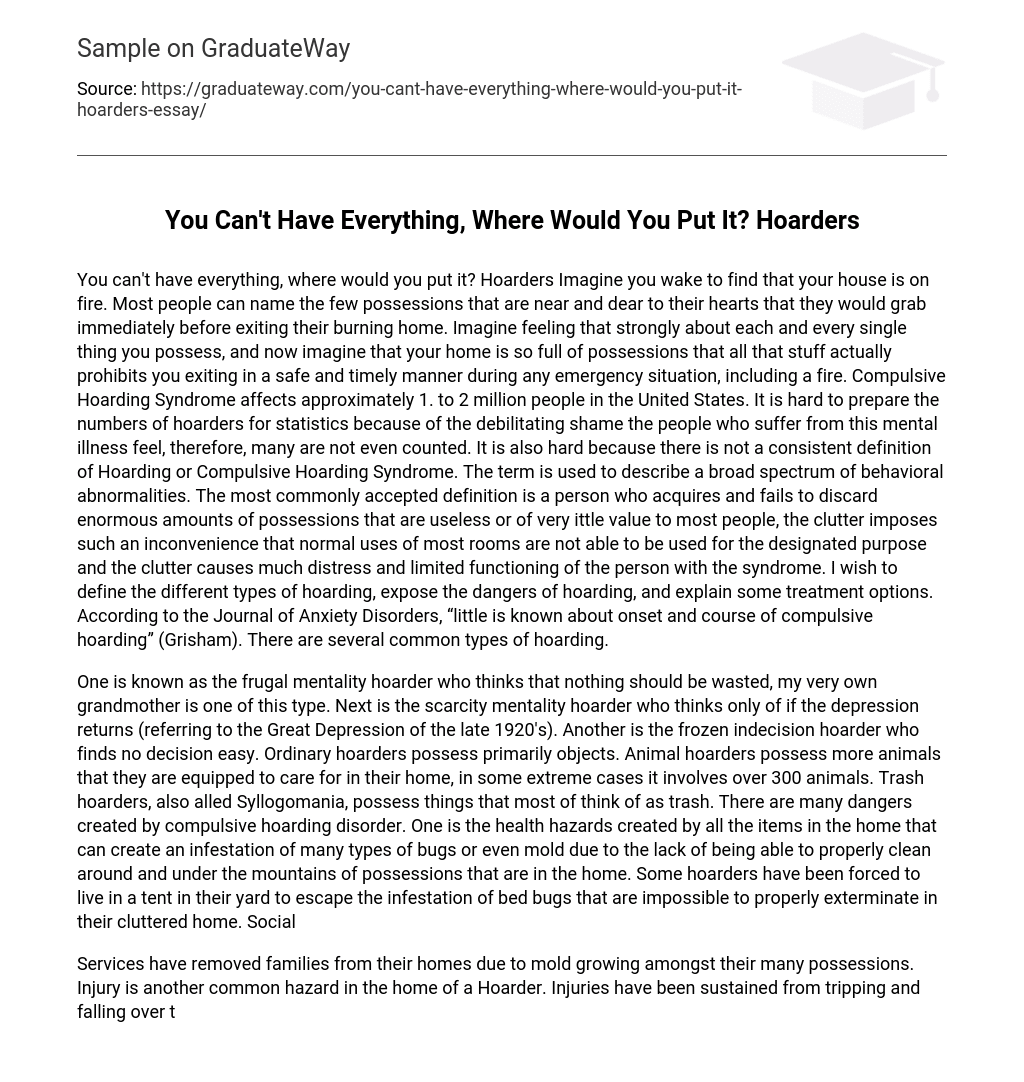You can’t have everything, where would you put it? Hoarders Imagine you wake to find that your house is on fire. Most people can name the few possessions that are near and dear to their hearts that they would grab immediately before exiting their burning home. Imagine feeling that strongly about each and every single thing you possess, and now imagine that your home is so full of possessions that all that stuff actually prohibits you exiting in a safe and timely manner during any emergency situation, including a fire. Compulsive Hoarding Syndrome affects approximately 1. to 2 million people in the United States. It is hard to prepare the numbers of hoarders for statistics because of the debilitating shame the people who suffer from this mental illness feel, therefore, many are not even counted. It is also hard because there is not a consistent definition of Hoarding or Compulsive Hoarding Syndrome. The term is used to describe a broad spectrum of behavioral abnormalities. The most commonly accepted definition is a person who acquires and fails to discard enormous amounts of possessions that are useless or of very ittle value to most people, the clutter imposes such an inconvenience that normal uses of most rooms are not able to be used for the designated purpose and the clutter causes much distress and limited functioning of the person with the syndrome. I wish to define the different types of hoarding, expose the dangers of hoarding, and explain some treatment options. According to the Journal of Anxiety Disorders, “little is known about onset and course of compulsive hoarding” (Grisham). There are several common types of hoarding.
One is known as the frugal mentality hoarder who thinks that nothing should be wasted, my very own grandmother is one of this type. Next is the scarcity mentality hoarder who thinks only of if the depression returns (referring to the Great Depression of the late 1920’s). Another is the frozen indecision hoarder who finds no decision easy. Ordinary hoarders possess primarily objects. Animal hoarders possess more animals that they are equipped to care for in their home, in some extreme cases it involves over 300 animals. Trash hoarders, also alled Syllogomania, possess things that most of think of as trash. There are many dangers created by compulsive hoarding disorder. One is the health hazards created by all the items in the home that can create an infestation of many types of bugs or even mold due to the lack of being able to properly clean around and under the mountains of possessions that are in the home. Some hoarders have been forced to live in a tent in their yard to escape the infestation of bed bugs that are impossible to properly exterminate in their cluttered home. Social
Services have removed families from their homes due to mold growing amongst their many possessions. Injury is another common hazard in the home of a Hoarder. Injuries have been sustained from tripping and falling over the mounds of clutter. People have even been crushed to their death from so many items being stacked to the ceiling that unexpectedly fall crushing them to the point that they are unable to break free to call for help. Finally, the isolation that people who hoard usually suffer from creates a hazard to addressing more serious roblems like depression, suicidal thoughts, or even something as simple as a leaky gas line not being properly fixed due to the shame of letting a repairman in the house to fix it. Just like the common cold, there is no cure for compulsive hoarding. Although compulsive hoarding accompanies OCD in approxamately 25% to 40% of individuals diagnosed “Traditional treatments for OCD have not proven to be effective with compulsive hoarders” (Saxena). Treatment includes “Intensive multimodal treatment found effective in pilot studies following a course of up to one year” (Saxena).
This treatment focused on discarding, organizing, preventing incoming clutter and introducing alternative behaviors. Compulsive hoarding is a dangerous, devastating disorder that is not well understood, lacks a consistent definition, has incomplete statistics and is difficult to treat. Works Cited Grisham, J. R. , R. O. Frost, G. Steketee, H. Kim, & S. Hood. (2006). Age of Onset of Compulsive Hoarding. Journal of Anxiety Disorders, 20, 675-686. Saxena, Sanjaya and Karron M. Maidment. (2004). Treatment of Compulsive Hoarding. JCLP/In Session, 60,(11), 1143-1154.





